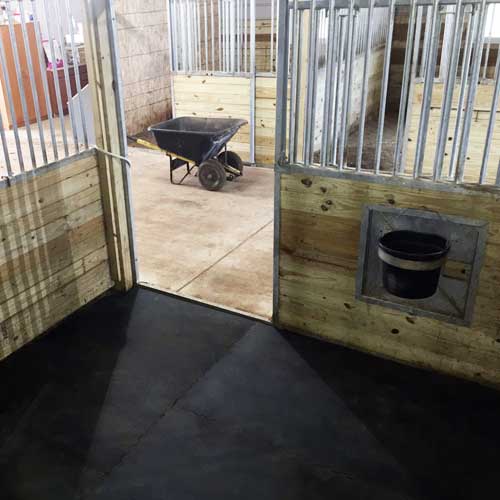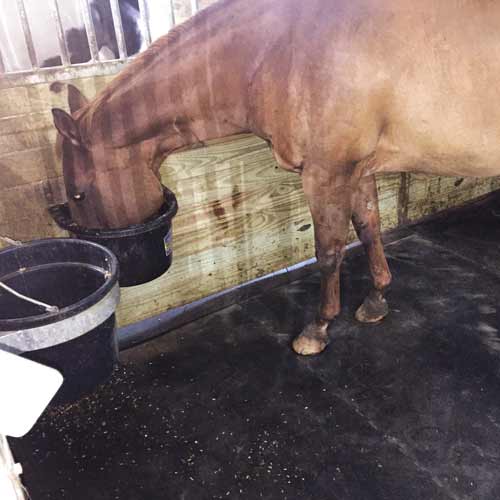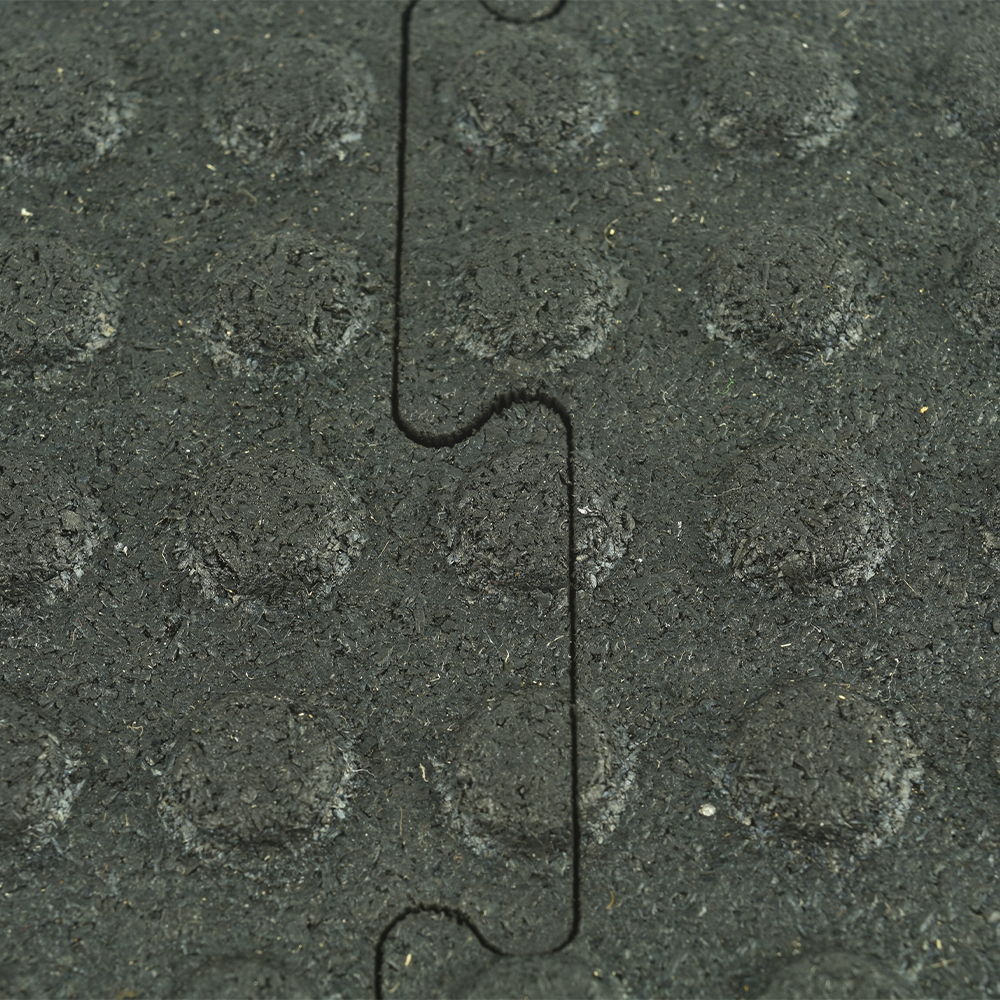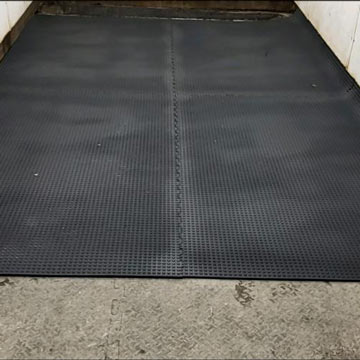What Are Stall Mats and What Are They Made Of?
Related Product: Horse Stall Mats Kit Cobblestone 3/4 Inch x 12x12 Ft.
What Are Stall Mats?
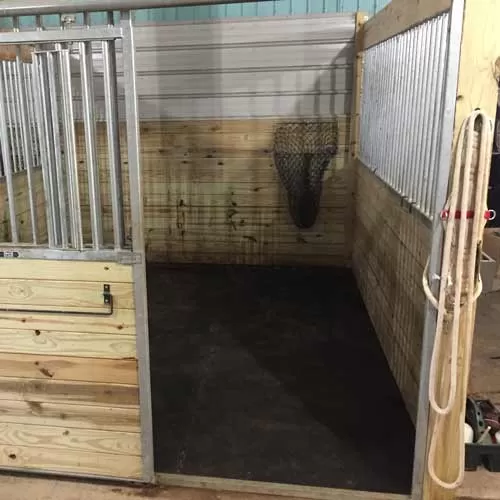
Stall mats are anti-skid floor mats that are used in large animal barns to aid the comfort and health of the animal. Due to their durability and versatility, stall mats can be used to add padding and reduce fatigue on horses or cattle when their barn stalls have a hard floor, such as concrete. They can also reduce the erosion of dirt or crushed rock stall floors due to pawing, pacing, or mucking.
Stall mats also make cleaning stalls easier as they keep bedding from getting mixed into loose subsurface material, and the non-absorbent rubber surface can be easily disinfected. They create a smooth surface for easier and faster cleaning, which can help to save on labor and bedding costs.
While stall mats are often used in stalls, you’ll also find them used in barn aisles, grooming stalls, and even trailer floors. The mats can help to add safety and comfort to all of these locations.
What Are Stall Mats Made of?
Stall mats are most often made of rubber, though some mats are made of high-density EVA foam. The rubber material can vary slightly, but it is most often created from recycled tires. Vulcanized rubber stall mats will be stronger and are completely waterproof, while non-vulcanized rubber may require a greater thickness to get the same durability. Additionally, liquids can permeate non-vulcanized rubber mats if they’re power-washed or soaked.Rubber is a top material choice for stall pads for several reasons. Rubber is supremely strong and is capable of supporting horses, including draft horses weighing a ton or more. Rubber can withstand the impact of horseshoes, including horseshoes with studs, and is durable enough to withstand hot shoeing, too.
Rubber also offers excellent shock absorption, which can help to make a surface more comfortable for your horse. It helps to buffer temperatures, shielding your horse from a cold concrete subfloor. Rubber also offers valuable traction to help keep both horses and handlers safe.
High-density foam stall mats are designed for portability. The mats tend to be lightweight, so you can easily take them to a horse show or other equine event, but some durability is sacrificed by making them lightweight and portable. This raises the question: Will EVA foam mats work for horse stalls? While EVA foam mats may be suitable for temporary or lightweight use, they are not as durable as rubber mats for long-term stall applications.
How Much Does a Stall Mat Weigh?
The weight of a stall mat is greatly dependent on the size, thickness, and material of the mat. A standard rubber stall mat is 4x6 feet in size and 3/4 inch thick. These mats typically run about 100 pounds per mat.You can find rubber stall mats that are thinner, have smaller dimensions, or are perforated, therefore reducing the weight. A 1/2 inch thick 4x6 stall mat will run closer to 75 pounds.
The super high-density 3/4 inch EVA foam portable horse stall mats are the lightest option at just 2 pounds per 2x2 foot tile.
What is the Best Flooring for a Horse Stall?
Entry level horse stall mats will typically be your straight-edge 4x6 mats. The thinner the mat, the lower the price in most cases, but also the more potential for curling or shifting, which can lead to tripping hazards or can let bedding work its way down under the mat.For best results, keep your stall mat thickness at 3/4 inch or thicker. You'll also want to make sure your seams are as tight as possible to prevent shavings and manure from working their way between the mats. Once this happens, you’ll start to see the seams buckle and the mats shift. This hazard will continue to worsen until it is fixed.
Interlocking stall mats offer a practical way to combat that problem. When placed over a perfectly level base, the interlocking mats can help to prevent separation and keep your stall floor nice and level.
Can Stall Mats Be Used Outside?
Yes, stall mats are made of a highly durable rubber, so they can absolutely be used outside. Many horse owners choose to use rubber stall mats in paddocks to create a surface for horses to eat off of so they don’t ingest sand.You can also use mats to create an outdoor wash bay. Rather than using solid horse stall mats, consider something that offers a little more traction. Washbay Button Top Rubber Mats feature a raised, textured surface to help maximize traction, even when the mats are wet. The Wash Rack Classic Interlocking Mat features generous perforations that allow water to drain quickly through the mat, so you and your horse won’t be standing in puddles during a bath.
Where Can You Buy Stall Mats?
We have a fantastic selection of horse stall mats available here at Greatmats. We offer many kits and individual stall mat sizes, so the mats are suitable for all different sorts of stall and barn dimensions. These heavy-duty mats are ideal for all sorts of farm and barn uses, and they’re available with several surface textures designed to maximize safety.Why Do Horse Stall Mats Smell, and Will They Stop Smelling?
Horse stall rubber mats smell because the rubber gives off volatile organic compounds. When the mats are stacked, those compounds are relatively trapped, but once you start moving the mats around and installing them in your barn, those compounds will be released, and you’ll notice a strong odor.Mats will eventually stop smelling so strongly, but it can take time. Our blog outlines several ways you can get rid of that rubber smell.
How Many Stall Mats Do I Need?
We sell many horse stall mat kits that are sized to fit in stalls of certain dimensions. Kits are available for 10x10, 12x12, 14x14 foot stalls, and more. The kits ensure you’ll have everything you need to completely floor your stall, and you won’t have to worry about cutting any mats.Additionally, we sell single mats that are 4x6 feet. If you’re planning a project, be sure to measure your space to determine how many 4x6-foot mats you’ll need.
How Thick Should Stall Mats Be for Horses?
Equine stall mats are usually ¾-inch thick, which is the recommended thickness for most horses and stalls. Some stall mats are available in a ½-inch thickness, but these thinner mats don’t provide as much cushion as the thicker option. The thinner mats are a better choice for use in barn aisles or grooming stalls. You can learn more about stall mat thicknesses and other recommendations in our blog.How Do I Keep My Stall Mats from Moving?
Stall mats are large and heavy, and the ¾-inch mats will typically stay in place pretty well on their own. When installing them, make sure that your stall subfloor is level and well compacted. Take the time to carefully cut any mats that need to be cut so that they fit together securely. You will periodically need to pull up the mats and re-level and compact your subfloor unless you have a concrete floor.You can also choose mats that interlock together, which can help keep them from moving. The interlocking mats create one larger, solid surface, so they’re less likely to shift than individual mats. As an added bonus, the interlocking design helps prevent bedding from working its way down in between the mats, leading to easier stall cleaning. You can read additional tips on how to keep your stall mats from shifting in our blog.
Can You Use Horse Stall Mats in a Gym?
Horse stall mats have many qualities that make them ideal for use in a gym. They’re thick enough to protect your subfloor from weights, and they’re supremely durable. The mats can withstand the weight of gym equipment, plus they help buffer temperatures and absorb sounds for a more enjoyable gym space.Keep in mind that horse stall mats have a very strong rubber smell when initially installed, so you’ll need to plan to let the mats air out and provide plenty of ventilation when you first install them. You can learn more about using horse stall mats for a gym in our blog.
